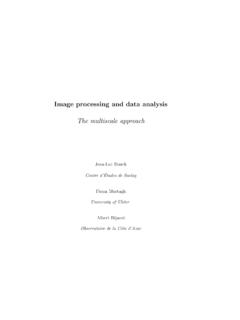Transcription of Final Report: Statistical Modeling and Analysis …
1 Final report : Statistical Modeling and Analysis Results for the Topsoil Lead Contamination Study (Quemetco Project). Submitted to: Prof. Shoumo Mitra Department of Agriculture Cal Poly Pomona Russell Plumb Masters Candidate Cal Poly Pomona report Prepared By: Scott M. Lesch Principal Statistician, GEBJ Salinity Laboratory Consulting Affiliate, Statistical Consulting Collaboratory University of California: Riverside, CA 92521. (951) 369-4861. Daniel R. Jeske Associate Professor, Department of Statistics Director, Statistical Consulting Collaboratory University of California: Riverside, CA 92521.
2 (951) 827-3014. Javier Saurez Student, Department of Statistics University of California: Riverside, CA 92521. January 28, 2006. Table of Content Executive summary i,ii,iii 1 Introduction . 1. 2 Sampling protocol . 2. 3 Basic summary statistics .. 5. 4 Analysis of the Sampling Depth Effect .. 18. 5 Exploratory Spatial Data Analysis Plots . 21. 6 Quantile Indicator Maps and Tests of Association . 30. 7 Contamination by Distance to Factory Plots 39. 8 Linear Spline Models 48. 9 References .. 56. Appendix: SAS code programs . 57. Executive Summary This report summarizes the Statistical Modeling and Analysis results associated with the Ca Poly Pomona Topsoil Lead Contamination study.
3 The purpose of this report is to document both the implemented sampling design and all corresponding data Modeling and inference techniques used during the subsequent Statistical analyses. The development of the sampling protocol, including both the initial recommended design and Final implemented sampling strategy are discussed in Section 2. The initial Stratified Random sampling design was developed using a Neyman allocation scheme. After presenting this design to the client, a refined GIS Analysis was performed and more accurate available sampling areas for each school were calculated.
4 These calculations were used to revise the second-stage random sampling scheme. Additionally, two extra properties were added to the sampling design (one nursery located within 2 Km of the factory and one previously overlooked park) and 12 additional sampling locations were selected along the factory perimeter. After these refinements, the Final sampling plan contained 361 sampling locations from 69 distinct non-factory properties (and the factory perimeter). The basic univariate statistics that summarize the contamination data associated with the analyzed metals (for all 360 topsoil samples) are given in Section 3.
5 A total of seven metal concentration measurements were made on each topsoil sample; the metals analyzed in this study include Arsenic (As), Cadmium (Cd), Chromium (Cr), Copper (Cu), Nickel (Ni), Lead (Pb), and Zinc (Zn). The univariate statistics summarize both the raw and natural log transformed metal data, where the transformed data is defined as Y = ln(X+1). The histograms and quantile plots of each log transformed metal data appear to be approximately symmetric (but in some cases also moderately heavy-tailed). Section 4 presents the Analysis of the sampling depth effect, based on the 43 sites were topsoil samples were acquired from two sampling Paired t-tests and sign- i rank tests are employed to determine what, if any, effect the sampling depth had on the observed metal concentration levels.
6 Both sets of tests suggest that there was no sampling depth effect at the level ( , the mean and/or median metal concentration levels did not change across sampling depths). Two types of exploratory data Analysis (EDA) plots for assessing the degree of spatial structure (present in the metal concentration data) are discussed in Section 5;. quatile maps and robust variogram plots. The quantile maps suggest that a substantial amount of short-range, local variation is present in the metal concentration data. Additionally, both the quantile maps and variogram plots suggest that distinct property effects may also be present; , samples gathers from within one property may be more similar (less variable) than samples gathered from different properties.
7 Section 6 introduces the idea of quantile indicator maps and describes the corresponding Chi-square tests of association that are derived from these maps. The corresponding Chi-square test results indicate that at the corrected significance level, an excessive number of Pb samples near the factory exceed both the median and q90 cut- offs. Additionally, an excessive number of Cr and Ni samples exceed the q90 cut-off. These results imply that an abnormally high number of hot ( , contaminated) Cr, Ni, and Pb samples occur within close proximity (< 2 Km) to the factory location. Section 7 presents the contamination by distance to factory (CD2F) plots.
8 These plots display the natural log transformed contamination levels for each metal as a function of the distance (of each sample site) to the factory, along with a smoothed spline function fitted to the resulting contamination pattern. The CD2F plots for Cr, Ni, and Pb display fairly clear evidence of an increasing contamination trend towards the factory. Finally, in Section 8 a mixed linear spline model is proposed for Modeling the distance to factory effect, while simultaneously adjusting for secondary covariates that were hypothesized to also (possibly) influence the metal contamination levels.
9 The fitted spline models are then used to estimate the Baseline, Factory, and Proximity effects. The ii Baseline effect estimates the background log contamination level across the survey region ( , the background level not influenced by the factory), the Factory effect estimates the log contamination level within or immediately around the perimeter of the factory, and the Proximity effect quantifies the distance to factory contamination relationship. These results agree with the earlier test results presented in sections 6 and 7. More specifically, they confirm that (i) the factory perimeter samples appear to be highly contaminated with respect to the estimated baseline metal contamination levels observed throughout the sampling region (for all metals), and (ii) at least two (and possibly three).
10 Of the seven metals analyzed in this study (Cr, Ni, and Pb) exhibit significantly elevated contamination levels near the factory site. iii Introduction This report summarizes all of the primary Statistical Modeling and Analysis results associated with the Ca Poly Pomona Topsoil Lead Contamination study. The purpose of this report is to document both the implemented sampling design and all corresponding data Modeling and inference techniques used during the subsequent Statistical analyses. Additionally, this report is designed to serve as a template for describing the sampling protocol and Statistical Analysis techniques in any future technical manuscripts developed by the client(s).









